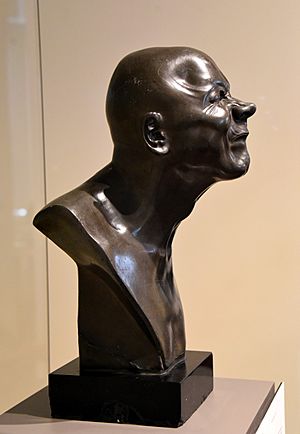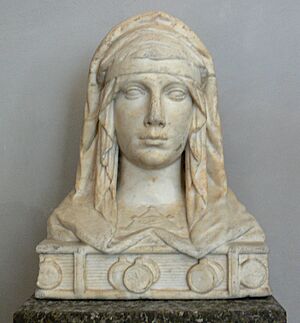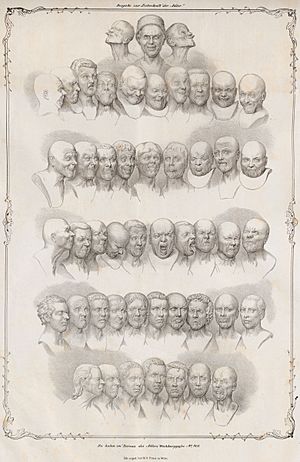Franz Xaver Messerschmidt facts for kids
Quick facts for kids
Franz Xaver Messerschmidt
|
|
|---|---|

Self portrait, c. 1780
|
|
| Born | February 6, 1736 Swabia, Germany
|
| Died | August 19, 1783 (aged 47) Pozsony, Hungary (today Bratislava, Slovakia)
|
Franz Xaver Messerschmidt (born February 6, 1736 – died August 19, 1783) was a German-Austrian sculptor. He is most famous for his unique "character heads." These are a collection of busts (sculptures of a person's head and shoulders) that show faces twisted into very strong facial expressions.
Contents
Early Life and Training
Franz Xaver Messerschmidt was born on February 6, 1736, in a town called Wiesensteig in Germany. He grew up in Munich with his uncle, Johann Baptist Straub, who was also a sculptor. His uncle taught him a lot about art. Franz also spent two years learning from another uncle, Philipp Jakob Straub, in Graz.
In 1755, he joined the Academy of Fine Arts Vienna. He became a student of Jacob Schletterer. After graduating, he started working for the imperial (royal) art collection. Between 1760 and 1763, he created his first known artworks. These included bronze busts of the royal couple. He also made reliefs (sculptures that stick out from a flat surface) of the crown prince and his wife.
His early works followed the Late Baroque art style. This style was popular in royal courts. He also made two large tin statues of the royal couple. These were ordered by Maria Theresa of Austria. Besides portraits, he created religious sculptures too.
Developing His Unique Style
Around 1769, Messerschmidt's art style began to change. He moved from the Baroque style to an early Neo-Classic style. This new style was simpler and more serious. He learned a lot from a trip to Rome in 1765. One of his early Neo-Classic works was a head of the famous doctor Franz Anton Mesmer.
Around 1770, Messerschmidt started working on his famous "character heads." These sculptures showed very unusual and strong facial expressions. Some people believe these works were connected to his personal struggles. He began to have difficulties and felt out of place.
In 1774, he wanted to become a leading professor at the academy where he taught. But instead, he was asked to leave. A letter to the Empress mentioned that his "confusion in the head" would make him unsuitable for the job.
Later Years and Focus on Character Heads
Feeling upset, Messerschmidt left Vienna. He went back to his hometown, Wiesensteig. Then he moved to Munich in the same year. He waited two years for a promised job at the Court, but it never came.
In 1777, he moved to Pressburg (now Bratislava). His brother, Johann Adam, also a sculptor, lived there. Franz spent his last six years living quietly on the edge of town. During this time, he mostly worked on his unique "character heads."
Creating the Character Heads
In 1781, a German writer named Friedrich Nicolai visited Messerschmidt. Nicolai wrote down their conversation. This writing is very important because it tells us why Messerschmidt made his character heads.
Messerschmidt told Nicolai that he would pinch his lower rib. Then, he would look in a mirror to see the strange faces he made. He would then sculpt these faces in marble or bronze. He wanted to show 64 different "grimaces" (twisted facial expressions) using his own face as a model.
Messerschmidt also talked about his interest in unusual and mysterious ideas. He was a follower of Hermes Trismegistus. He believed in finding "universal balance" in art. He felt that his character heads had angered a "Spirit of Proportion." He claimed this spirit visited him at night. One of his most famous heads, The Beaked, was supposedly inspired by these experiences.
See also
 In Spanish: Franz Xaver Messerschmidt para niños
In Spanish: Franz Xaver Messerschmidt para niños












